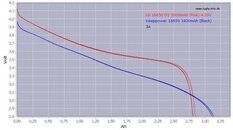Thanks for the replies. So basically you guys are saying yes.. And no. Hahaha
Protection circuit sounds good for my use and to prevent overcharging.. I can find stuff like this but still not sure if the circuits are all the same:
2 Panasonic NCR18650B Li ion Battery 3400mAh 3 7V 18650 New Protection PCB Japan | eBay
I did a bit of research for 18650 batteries and ended up buying these: LG ICR18650E1 - 18650 - 3200mAh 4.35v
I was going to buy the Panasonic NCR18650B because it was popular but chose the LGs because they stay brighter longer but have a steep curve towards the back end as the battery is discharged. Basically comes down to useful lighting. LGs are also much cheaper. The Panasonics have a gradual sloping curve, so your light will gradually get dimmer and dimmer from the onset whereas the LGs will stay brighter longer but then falls off steeply closer to full discharge. Depends on what you prefer. Talk to the seller who owns the business. Very helpful person. He will tell you the difference so you can make an informed decision.
Protection circuit also prevents discharging beyond a certain point of ruining the battery. I chose unprotected because if I need a light in an emergency situation while diving, I'd rather ruin a battery to be able to see in the dark. They also make protected LGs.





